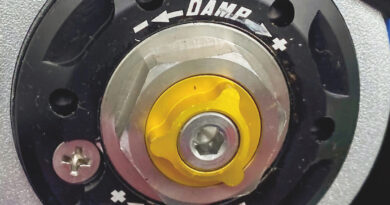Dewhel spark plug coil removal tool
Something doesn’t have to be complicated to be a stroke of genius or extremely useful. Think of all the things you’ve done with a plain old screwdriver! Sure, there may have been some incidental damage incurred by not using the proper tool, but you got the job done in the absence of a more elegant solution. At the other end of the spectrum, there are tools so specialized they’ll get precious little use during a home mechanic’s lifetime, but they might still be worth the expense if they make a big difference on those rare occasions. When such a tool doesn’t cost much, the acquisition decision is easy to make.
R-series motors present their spark plugs (and valve trains) to the world as few motors do; could access be any easier? Maybe not on vintage machines, but late-model boxers with the coils built into the spark plug caps can present more of a challenge. Rubber seals around the coil assembly fit extremely snugly in the spark plug tunnel and it’s hard for fingers to find purchase on the exposed end. You wouldn’t want to grab that end with pliers, since it’s plastic and filled with potentially fragile electronics, and there’s no place to stick that all-purpose screwdriver to lever the whole thing out. Dewhel makes the task as simple as it ought to be with their handsomely anodized, machined aluminum coil removal tool.
First a note on liberating the spark plug wire from the coil assembly. The little gray tab facing you must be pulled out away from the coil to allow it to swivel at its base. You then press it while tugging the connector away from the coil. This wasn’t exactly clear in BMW’s IKEA-like instructions. Obviously, prior to this you’ll have to remove any cylinder guards that would obstruct access, along with the plastic strip spanning the valve cover.

With the coil assembly thus disconnected, you simply slip the removal tool onto the opposite side; it will slide into a circumferential groove and lock in place. Now you can pull the coil assembly out of the head with only a bit of a struggle—worlds easier than doing so without the tool. Just make sure you already have a socket of the correct size, length, and thickness to reach the plug once you get this far (my 1250 took a thin-walled 14mm socket about 5” long, but check your model’s spark plug size). It’s best to use a true spark plug socket, either magnetized or equipped with an internal rubber sleeve to grip the plug’s porcelain tower. Also, check for dirt inside the tunnel before removing the plug and blow it out with compressed air. You don’t want to take any chance of accidentally knocking debris into the cylinder through the empty spark plug hole. Also, notice the coil has a ridge that mates to a groove in the tunnel as you reassemble everything.

This tool fits the coils on a wide range of R-, F-, and K-series bikes. It’s no less useful on non-boxers, but gaining access to the cylinder heads is a much more involved process without them hanging in the breeze, likely requiring consultation with a shop manual. Given the mileage between recommended spark plug changes (12,000 on my bike), you may not need the coil removal tool very often, but when you do, it’s a game changer—and quite economically priced at $11.99 on Amazon (available in blue or red).

Note: This is one of those Amazon items carrying a dubious variety of brand names, despite identical construction. At the time of my purchase, Dewhel had the lowest price, but that could change by the time you read this.



